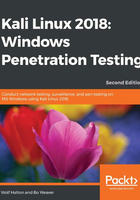
Desktop environment versus Window Manager
One important distinction that may help you understand how Desktop Environments work on Kali and other Linuces (plural of Linux) is that of the Window Manager. A desktop environment, also called a GUI, generally includes folders, wallpapers, desktop widgets, icons, windows, toolbars, and interfaces for applications. The Microsoft Windows desktop environment may have been the first such metaphorical construct you discovered. Your smartphone has a desktop environment, and the dramatic failure of the Windows 8 desktop environment was an attempt to merge development of the Windows CE (phone GUI) and Windows 7/Server 2003 GUI. The mistake Microsoft made was assuming that there were more workstations with touch screen capability. Plainly the technology existed, but the monitors were expensive and not in wide use. Bo and Wolf think the Ubuntu Unity desktop environment was a failure based upon the same design assumption. Mouse-driven workstation interfaces are here to stay for a little while longer.
In Kali, a desktop environment usually interacts with a Windowing System such as the X Windows System, or Wayland, which runs directly on top of the hardware, and a Window Manager application which is the interface the user sees and with which the user interacts. The Window Manager provides the look and feel of the Kali Linux experience. There are several Window Managers that can be used with almost any desktop environment in Kali Linux. One of these is the Enlightenment Window Manager, which is included in Kali ISO downloads as E17. The main difference between E17 and a full desktop environment, such as KDE or Gnome, is that E17 has few applications that are built specifically for E17, whereas KDE and Gnome have specialized apps that need a large number of dependencies met to run them in some other desktop environment. Kate and gedit are the specialized text editors for KDE and Gnome respectively.